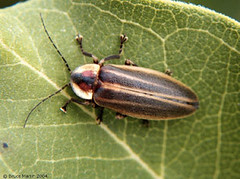The Power Went Out and I Saw a Firefly
Gene and I spent the evening outside last night because of the big eight-county-wide power outage. It was actually a nice evening once it cooled off. Kinda breezey. We had candles and a lantern and Gene brought his guitar out and provided our entertainment. During the evening, I spotted a firefly. We've been here more than ten years and that's the first one I've seen here.

Coleoptera: LampyridaeWhen I was a little kid, my dad would have everything ready -- the boat hitched up, car loaded -- and we'd hop in the car right after church on Sunday night or Wednesday night and head to the river. My dad would launch the boat by flashlight and we'd pile everything in and head to my uncle's fish camp on the banks of the Neches River. It seemed like hours to get there but was probably only two or three miles. But riding in that little John boat at night continues to be one of my favorite memories. The riverbanks were thick with fireflies. The drone of the boat motor lulled me into an imaginary world where I was on a river journey and passing a fairy metropolis. There were thousands of them. I miss seeing them like that.
Putting five or six in a jar and having light in your room as you went to sleep was something all kids did at least once when I was a kid. I haven't seen five or six in one place in decades nor could I fathom capturing them in a jar. Catching fireflies was one of the things that kids did to pass the time while our parents were standing around talking after church.
• Fireflies are long, soft-bodied beetles, up to 3/4 inch long. The first segment of the thorax hides the head from above. Most larger members have light-producing organs on the end of the abdomen. Most smaller species do not. The females of some species are wingless and look like larvae. The larvae are flattened, have toothed edges, and may also glow.
• Firefly larvae are predatory on insects, slugs, and snails. The adults mostly do not feed, but may take an occasional meal of pollen or nectar.
• Fireflies have complete metamorphosis and the larvae live in the soil. Adult lights are used to get the sexes together, with each species having its own unique flashing pattern.
• One genus, Photuris LINK ,will even mimick flashing patterns of other species luring them in for a tasty snack.

Coleoptera: Lampyridae
Putting five or six in a jar and having light in your room as you went to sleep was something all kids did at least once when I was a kid. I haven't seen five or six in one place in decades nor could I fathom capturing them in a jar. Catching fireflies was one of the things that kids did to pass the time while our parents were standing around talking after church.
• Fireflies are long, soft-bodied beetles, up to 3/4 inch long. The first segment of the thorax hides the head from above. Most larger members have light-producing organs on the end of the abdomen. Most smaller species do not. The females of some species are wingless and look like larvae. The larvae are flattened, have toothed edges, and may also glow.
• Firefly larvae are predatory on insects, slugs, and snails. The adults mostly do not feed, but may take an occasional meal of pollen or nectar.
• Fireflies have complete metamorphosis and the larvae live in the soil. Adult lights are used to get the sexes together, with each species having its own unique flashing pattern.
• One genus, Photuris LINK ,will even mimick flashing patterns of other species luring them in for a tasty snack.

0 Comments:
Post a Comment
<< Home